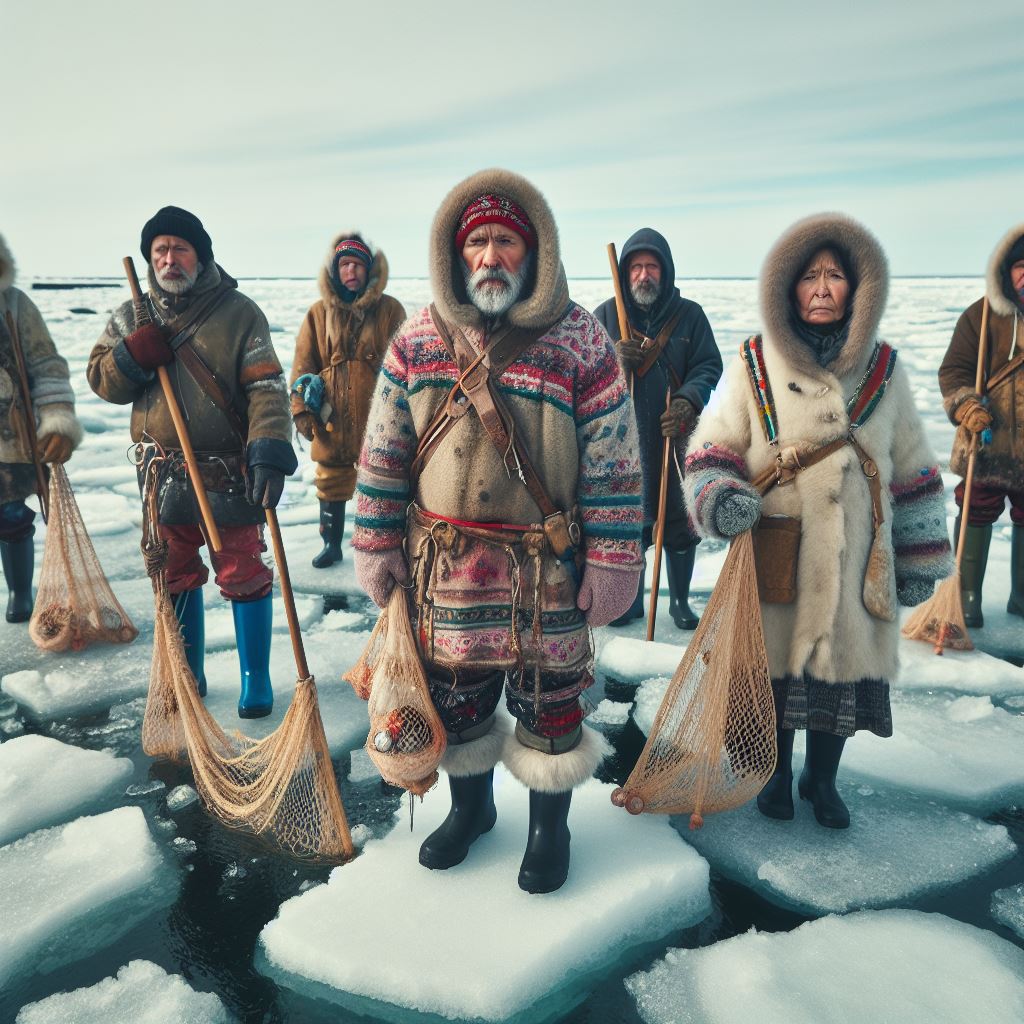Introduction
Overview of climate change and its impact on various ecosystems around the world
Climate change is a pressing issue that affects ecosystems worldwide, including the Canadian fishery industry.
The increasing temperatures, changing precipitation patterns, and rising sea levels have significant impacts on this sector.
The importance of Canadian fishery industry and its vulnerability to climate change
The Canadian fishery industry plays a vital role in the country’s economy, providing livelihoods for many communities and supplying food to domestic and international markets.
However, it is highly vulnerable to climate change.
The changing ocean conditions alter fish distribution, migration patterns, and reproductive cycles.
This disruption threatens the abundance and diversity of fish stocks, impacting both commercial and recreational fishing.
Furthermore, rising sea temperatures and ocean acidification pose additional challenges, as they affect the health and resilience of marine species and their habitats.
Climate change also leads to the emergence of new pests and diseases, further compromising the fishery industry.
These environmental changes directly affect the livelihoods of fishers, fishing communities, and coastal industries.
Additionally, the impacts ripple throughout the entire supply chain, including processors, distributors, and consumers.
Consequently, addressing the effects of climate change on Canadian fisheries is crucial for sustainable resource management and the conservation of biodiversity.
Implementing adaptive measures, such as fisheries management strategies, diversification of livelihoods, and supporting fishers in transitioning to more sustainable practices, are necessary to mitigate the adverse impacts of climate change on the Canadian fishery industry.
By recognizing the vulnerability of this vital industry, steps can be taken to protect and sustainably manage Canadian fisheries in a changing climate.
The Effect of Rising Water Temperatures
How climate change leads to an increase in water temperature
Climate change directly contributes to the increase in water temperatures.
As greenhouse gas emissions continue to rise, the planet’s average temperature also increases.
This phenomenon, known as global warming, leads to elevated water temperatures in lakes, rivers, and oceans.
Higher water temperatures have significant impacts on the behavior, distribution, and reproduction of fish species.
How Rising Water Temperatures Affect Fish Behavior
Fish are ectothermic organisms, meaning their body temperature is determined by the surrounding environment.
As water temperatures increase, fish become more active, seeking cooler areas and rapid movement.
They may migrate to higher latitudes or deeper waters to find suitable temperature conditions.
Some fish species tend to experience increased aggression and competition for resources due to rising temperatures.
Changes in behavior also affect the feeding patterns and predator-prey relationships among fish populations.
Impact of Rising Water Temperatures on Fish Distribution
The distribution of fish species is closely linked to the availability of suitable habitats and acceptable temperature ranges.
As water temperatures rise, fish tend to shift their distribution, moving towards cooler areas and higher altitudes.
This ecological shift causes changes in the structure and composition of fish communities.
Unlock Your Career Potential
Visualize a clear path to success with our tailored Career Consulting service. Personalized insights in just 1-3 days.
Get StartedSome species may become locally extinct in certain areas, while others may invade new habitats.
Fish migration patterns are also affected by temperature changes, leading to alterations in seasonal movement and spawning behaviors.
Effects of Rising Water Temperatures on Fish Reproduction
Temperature plays a crucial role in fish reproduction, influencing the timing and success of spawning.
Many fish species rely on specific temperature thresholds for successful egg development and hatching.
With increasing water temperatures, the reproductive capacity of fish species can be compromised.
Elevated temperatures may lead to earlier or delayed spawning, reduced egg survival rates, and abnormal larval development.
These effects can ultimately result in population declines and reduced recruitment of fish species.
Fish Species Impacted by Rising Temperatures in Canadian Waters
Several fish species found in Canadian waters are particularly vulnerable to the effects of rising temperatures.
Atlantic salmon, a culturally and economically significant species, heavily relies on specific temperature conditions for successful reproduction.
Walleye, a popular game fish, is also sensitive to temperature changes, affecting its behavior and distribution.
Lake whitefish, Arctic char, and trout species are among others that face threats from rising water temperatures.
Understanding the impacts of climate change on fishery is essential for effective management and conservation strategies.
By addressing the root causes of rising temperatures and implementing adaptive measures, we can mitigate these effects and secure the future of Canadian fish species.
Read: Fishing Industry: Trends in Canadian Waters
Ocean Acidification and its Consequences
Increased carbon dioxide emissions contribute to ocean acidification, leading to several negative impacts on marine life.
How increased carbon dioxide emissions contribute to ocean acidification
When carbon dioxide is released into the atmosphere, a portion of it is absorbed by the ocean surface.
This absorbed carbon dioxide undergoes a chemical reaction that increases the concentration of hydrogen ions in the water.
This increase in hydrogen ions makes the water more acidic, leading to a decrease in pH levels.
The main source of carbon dioxide emissions is the burning of fossil fuels, such as coal and oil.
Human activities, including industrial processes and deforestation, further contribute to these emissions.
How acidification affects the growth, shell formation, and survival of various fish species
Ocean acidification has a significant impact on the growth, shell formation, and survival of marine organisms, including various fish species.
As the water becomes more acidic, it impedes the growth and development of fish larvae and juveniles.
High acidity levels also hinder the ability of fish to build and maintain their protective shells and skeletons.
Species that rely on calcium carbonate, such as shellfish, are especially vulnerable to acidification.
Changes in the availability of food sources due to acidification can lead to reduced fitness and reproductive capacity in fish populations.
Examples of the consequences of ocean acidification on Canadian fish stocks
Ocean acidification in Canadian waters poses significant threats to the country’s fish stocks and fisheries industry.
The decline in shellfish populations, such as oysters and clams, has been observed along the Atlantic and Pacific coasts.
These declines have resulted in economic losses for shellfish farmers and a decrease in seafood availability for consumers.
Among the fish species impacted by acidification are Atlantic cod, lobster, and salmon, all of which are commercially important for Canada.
Altered behavior and reduced survival rates of these fish species can have severe consequences for the fishing industry.
The interconnectedness of marine ecosystems means that changes in one species can have cascading effects on the entire fishery.
Protecting and restoring the health of Canadian fish stocks requires mitigating climate change and reducing carbon dioxide emissions.
Efforts to improve water quality, such as reducing nutrient pollution, can also help mitigate the effects of acidification.
Summarily, Ocean acidification, caused by increased carbon dioxide emissions, has severe consequences for Canadian fish stocks and the overall fishery industry.
The negative effects on growth, shell formation, and survival of various fish species highlight the urgent need for mitigation strategies.
By addressing climate change and reducing carbon emissions, we can protect this vital natural resource and sustainably manage our marine ecosystems.
Read: Career Paths in Canada’s Fishing Industry
Changes in Ocean Currents and Circulation Patterns
Climate change has a significant impact on the Canadian fishery, particularly through changes in ocean currents and circulation patterns.
These alterations disrupt the delicate balance of the marine ecosystem, affecting nutrient availability, food chain dynamics, and the migration patterns of fish.
Ocean currents play a vital role in regulating temperature, distributing nutrients, and driving the circulation of water around the world.
However, climate change is causing disruptions in these currents and patterns.
As sea ice melts due to rising temperatures, freshwater is released into the ocean, affecting the density and salinity of seawater.
This alteration can lead to changes in ocean currents and circulation patterns.
How Climate Change Alters Ocean Currents and Circulation Patterns
Climate change alters ocean currents and circulation patterns primarily through the melting of glaciers and the polar ice caps.
This process injects massive amounts of freshwater into the ocean, diluting the saltwater and disrupting the natural balance.
As a result, the ocean currents are weakened or even redirected, leading to significant changes in circulation.
Additionally, changes in wind patterns caused by climate change can also affect ocean circulation.
These alterations in wind direction and intensity can impact the movement and strength of ocean currents.
Effects on Nutrient Availability, Food Chain Dynamics, and Fish Migration
The changes in ocean currents and circulation patterns have profound effects on nutrient availability, food chain dynamics, and fish migration.
These impacts have severe consequences for Canadian fisheries.
Nutrient availability is disrupted as altered ocean currents cause changes in the distribution of nutrients.
Nutrient-rich waters may be redirected or become less accessible to certain areas, affecting the productivity of phytoplankton and other primary producers.
This disruption in nutrient availability then ripples through the food chain, impacting zooplankton, small fish, and ultimately larger predators.
Changes in the prey-predator dynamics can lead to imbalances in the ecosystem and even the collapse of certain fish populations.
Furthermore, altered ocean currents and circulation patterns can disrupt the migration patterns of fish.
Some species rely on specific temperature ranges, current flows, or habitat conditions for successful migration or reproduction.
Any disruptions in these patterns can hinder fish populations from reaching their necessary breeding or feeding grounds.
Examples of Affected Canadian Fish Species
Several Canadian fish species are directly affected by changes in ocean currents and circulation patterns caused by climate change.
These species face challenges in their survival, reproduction, and overall population health.
Sockeye Salmon (Oncorhynchus nerka)
Sockeye salmon is an iconic Canadian fish species, and its population is greatly impacted by climate change.
Changes in ocean currents affect their migration routes and timing, making it harder for them to reach their spawning grounds.
Atlantic Cod (Gadus morhua)
Atlantic cod populations in the North Atlantic Ocean have declined due to changes in ocean currents and warming waters.
These changes affect their food availability and impact their overall reproductive success.
Northern Shrimp (Pandalus borealis)
Northern shrimp populations have declined in the Gulf of St. Lawrence due to climate change.
Altered ocean currents disrupt the suitable temperature and salinity conditions they rely on for successful reproduction and survival.
Pacific Herring (Clupea pallasii)
Pacific herring populations on the West Coast of Canada are facing challenges from changes in ocean currents.
Their feeding grounds are shifting due to alterations in nutrient availability, impacting their overall health and productivity.
In essence, climate change is significantly altering ocean currents and circulation patterns, affecting the Canadian fishery in numerous ways.
The disruption of nutrient availability, food chain dynamics, and fish migration patterns poses serious challenges to the health and sustainability of fish populations.
It is crucial to address climate change and its impacts on the Canadian fishery to ensure the long-term survival and productivity of this vital industry.
Read: Sustainable Practices in Canadian Fishing

Loss of Habitat and Coastal Erosion
How climate change contributes to coastal erosion and loss of critical fish habitats
Climate change exacerbates coastal erosion, leading to the loss of critical fish habitats.
As climate change increases global temperatures, it is causing the melting of glaciers and ice caps.
This melting releases vast amounts of freshwater into the oceans, disrupting the delicate balance of saltwater and freshwater ecosystems.
The higher level of freshwater dilutes the salinity of coastal waters, making them less favorable for many fish species.
How the loss of habitats and coastal areas affects the reproduction, feeding, and survival of fish species
Coastal erosion is accelerated by rising sea levels, caused by the thermal expansion of seawater and the melting of ice.
With weakened coastlines, fish habitats such as estuaries, salt marshes, and coral reefs are being destroyed.
These habitats serve as essential breeding grounds and nurseries for various fish species.
Loss of habitats directly impacts the reproduction, feeding, and survival of these fish species.
Without suitable areas to spawn, fish populations decline, leading to a decrease in overall biodiversity.
Furthermore, the loss of critical feeding grounds hampers the growth and development of fish species.
A decrease in food availability affects the size, health, and maturity of fish populations, ultimately affecting their abundance.
Coastal erosion also exposes fish species to greater vulnerability from external threats.
Without protective habitats, fish are more susceptible to predation and habitat fragmentation.
They lose the natural barriers that shield them from larger marine predators and human activities.
Examples of Canadian regions where coastal erosion is causing significant damage to fish habitats
In addition to the general impact on fish species, there are specific regions in Canada that are experiencing significant damage due to coastal erosion.
The Atlantic coast, particularly in regions like Newfoundland and Labrador, is facing extensive habitat loss.
These areas are witnessing the disappearance of crucial fish habitats such as salt marshes and tidal flats.
The Gulf of St. Lawrence is also heavily impacted, with its delicate ecosystems being eroded and degraded.
Moreover, northern regions like the Arctic are experiencing the loss of ice shelves, affecting fish species adapted to cold climates.
The consequences of coastal erosion go beyond the immediate loss of fish habitats.
It disrupts the entire marine food chain, affecting the balance and sustainability of fish populations.
Efforts to mitigate climate change and adapt to the effects of coastal erosion are crucial.
Protecting and restoring fish habitats, including the preservation of coastal wetlands, is essential.
In review, climate change exacerbates coastal erosion, leading to the loss of critical fish habitats.
The repercussions on fish species’ reproduction, feeding, and survival are significant, and certain Canadian regions are already experiencing significant damage.
Urgent action is needed to address these consequences and ensure the long-term sustainability of Canada’s fishery industry.
Read: Navigating Fishing Regulations in Canada
Implications for the Canadian Fishery Industry
The Canadian fishery industry is facing significant challenges due to the effects of climate change.
These challenges have far-reaching economic and social consequences that need to be addressed urgently.
The economic and social consequences of climate change on the Canadian fishery industry
Climate change has led to rising sea temperatures and shifting ocean currents, which directly impact fish populations.
As a result, the catch potential and overall profitability of commercial fishing operations have been severely affected.
Moreover, declining fish stocks and changing fish behavior pose further challenges to the industry.
Fish are migrating to new areas in search of more suitable environments, making it difficult for fishing operations to predict and target their usual catch.
This uncertainty has profound implications on the future sustainability and profitability of the Canadian fishery industry.
How declining fish stocks and changing fish behavior impact commercial fishing operations
Declining fish stocks directly affect commercial fishing operations as there is a reduction in the availability of target species.
This leads to reduced catches and diminished market supply, ultimately impacting the revenue and economic viability of fishing companies.
The changing behavior of fish also poses challenges.
With altered migratory patterns and feeding habits, fishing operations need to adapt their strategies to match the new behavior.
This often involves changing fishing locations, equipment, and techniques, which can be costly and time-consuming for the industry.
Potential implications for fishery jobs, food security, and traditional Indigenous fishing practices
The implications of climate change on the Canadian fishery industry go beyond economic concerns.
A major concern is the potential loss of fishery jobs, which can lead to unemployment and economic hardship in coastal communities reliant on the industry.
Furthermore, the decline in fish stocks can have severe consequences for food security, as fish is an important source of protein for many Canadians.
With reduced catches, there is a risk of increased reliance on imports to meet the demands, which can be costly and may compromise domestic food security.
Additionally, climate change affects traditional Indigenous fishing practices, which have deep cultural significance and provide sustenance for many Indigenous communities.
The disruption of fish behavior and availability threatens both the cultural heritage and food sovereignty of Indigenous peoples.
Ultimately, climate change has severe implications for the Canadian fishery industry.
The economic and social consequences are evident, with declining fish stocks, changing fish behavior, potential job losses, food security concerns, and threat to traditional Indigenous fishing practices.
It is crucial for stakeholders to collaborate and implement effective strategies to mitigate the impacts and ensure the sustainability of the industry.
Explore Further: A Day in the Life of an Env. Engineer in Canada
Mitigation and Adaptation Strategies
Climate change has had a significant impact on the Canadian fishery industry.
Various measures to mitigate and adapt to the effects of climate change on Canadian fisher
To address these effects, various measures have been introduced to mitigate and adapt to the changing conditions.
Sustainable Fishing Practices
One of the key strategies for mitigating climate change effects on Canadian fishery is the adoption of sustainable fishing practices.
These practices focus on maintaining balanced fish populations by considering factors like species abundance, minimum size limits, and fishing quotas.
By implementing these practices, the fishery industry aims to reduce overfishing and protect vulnerable species, ensuring the long-term viability of the sector.
This includes promoting responsible fishing techniques such as the use of selective nets and gear modifications to minimize bycatch.
Habitat Restoration Efforts
Another significant measure to mitigate climate change effects is the restoration of fish habitats.
This includes rehabilitating degraded spawning areas, improving water quality, and addressing coastal erosion.
Restoring fish habitats allows for the revival of fish populations, as it provides them with suitable locations for reproduction, feeding, and shelter.
Additionally, it improves the overall health and resilience of ecosystems, which in turn helps mitigate the impacts of climate change.
Resource Management
Efficient resource management is crucial for adapting to climate change and protecting fishery resources.
This includes monitoring fish stocks, implementing sustainable harvest strategies, and employing advanced technologies for data collection and analysis.
By closely monitoring fish populations and their distribution, resource managers can make informed decisions about fishing seasons, catch limits, and protected areas.
This adaptive approach ensures that the industry can respond to changes in fish behavior and habitat distribution caused by climate change.
Importance of International Cooperation and Policies
Addressing climate change and protecting fishery resources require international cooperation and the implementation of effective policies.
Fish species often migrate across borders, making it essential to coordinate efforts and share knowledge.
International cooperation can facilitate the development of sustainable fishing practices and the exchange of best management strategies.
Collaborative research initiatives can help assess the impacts of climate change on fish populations and develop innovative conservation measures.
Furthermore, policies at the national and international levels play a crucial role in managing and protecting fishery resources.
These policies should prioritize sustainable development, advocate for ecosystem-based management, and promote the integration of climate change considerations into fishery management plans.
The effects of climate change on the Canadian fishery are significant; however, through the implementation of mitigation and adaptation strategies, the industry can thrive in the face of these challenges.
In the end, By adopting sustainable fishing practices, restoring fish habitats, employing effective resource management, and promoting international cooperation and policies, Canada can safeguard its fishery resources and ensure their long-term sustainability.
Taking proactive measures and addressing climate change is essential to ensure that future generations can continue to enjoy the benefits of a thriving Canadian fishery industry.
Conclusion
The major effects of climate change on Canadian fishery
In closing, climate change has had significant and detrimental effects on the Canadian fishery industry.
The rising temperatures and changes in ocean currents have disrupted the natural habitat of fish, leading to altered migration patterns and reduced populations.
Additionally, the acidification of oceans due to increased CO2 levels has negatively impacted the growth and survival of marine organisms.
Thoughts on the importance of addressing climate change to sustain the fishery industry in Canada
Addressing climate change is of utmost importance to sustain the fishery industry in Canada.
Without immediate action, the consequences will exacerbate, leading to further economic losses and environmental damage.
It is crucial for governments, individuals, and organizations to recognize the urgency and take proactive measures to combat climate change.
Call to action for individuals, governments, and organizations to take steps towards combating climate change and protecting fishery resources
To protect fishery resources and ensure their future viability, there needs to be a collective effort.
Individuals can contribute by adopting sustainable fishing practices and reducing carbon emissions in their daily lives.
Governments should enact policies that incentivize the use of renewable energy sources and support research on climate change’s impact on fisheries.
Additionally, organizations should collaborate to develop strategies for adapting to changing circumstances and implement measures to reduce their environmental footprint.
By working together, we can mitigate the effects of climate change on the Canadian fishery industry and secure a sustainable future for generations to come.
It is imperative that we act now to preserve our fishery resources and protect the livelihood of those dependent on this vital industry.
Let’s take action to combat climate change and safeguard the future of Canadian fisheries.




